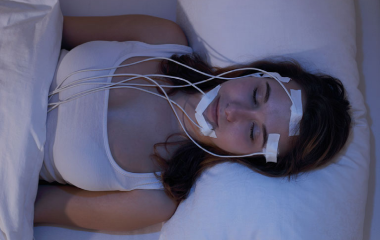About 70 million Americans suffer from sleep problems. If you suspect you may have a sleep disorder, a sleep study at an AASM-accredited sleep center is the best way to find out. Below are answers to some of the most common questions about sleep studies.
Q: How can I determine if I need a sleep study?
A: Your board-certified sleep medicine physician will decide if you need a sleep study. The first step in determining whether you have a sleep disorder might not necessarily be a sleep study, says Dr. Helene Emsellem, Medical Director for the Center for Sleep & Wake Disorders in Chevy Chase, Md. The sleep physician will first attempt to determine the nature of a sleep problem and its treatment. This includes a sleep diary to track your sleep-wake pattern, your complete medical history and a physical examination. If the sleep physician thinks you may have obstructive sleep apnea (OSA), a hypersomnia such as narcolepsy or a parasomnia such as sleep walking or nocturnal eating, then he or she will recommend a sleep study. In many cases, the physician will recommend a home sleep apnea test if he or she suspects you have sleep apnea. Other sleep disorders such as insomnia and restless legs syndrome (RLS) do not require a sleep study to diagnose, but rather history.
Q: What will a sleep study tell me?
A: A standard in-lab sleep study (polysomnogram) records information that allows the sleep physician to evaluate the sleep stages and their sequence during the night. The in-lab sleep study records EEG activity, eye movements and muscle tone. The EEG data tells us how quickly an individual falls asleep and the presence of early onset Rapid Eye Movement (REM) sleep may suggest sleepiness and a possible disorder of alertness, says Emsellem. Airflow through the nose and mouth is recorded to figure out if there are abnormalities to help us determine if sleep apnea is present. The simultaneous recording of heart rate, oxygen saturation, airflow flow and respiratory effort allows us to analyze the types of breathing abnormalities present and their impact on oxygenation, cardiac function and sleep continuity. Limb movements are recorded to detect extraneous movements, possible seizure activity and periodic limb movements of sleep. The in-lab sleep study is recorded on video so that sleep talking and unusual behaviors may be documented. Home sleep apnea tests collect data that the physician requires to diagnose sleep apnea – usually your breathing and blood oxygen level.
Q: What treatments are available for sleep disorders?
A: Treatments vary depending on the diagnosis. Some of the most common types of sleep disorders include insomnia, sleep apnea, narcolepsy, restless legs syndrome, parasomnias and snoring.
Q: What other tools do physicians use to determine if I have a sleeping disorder?
A: There are a variety of tools used, including a sleep diary to track the sleep-wake schedule, the Epworth Sleepiness Scale and Stanford Sleepiness Scale, to assess the subjective degree of sleepiness present, the STOP-Bang sleep apnea screening questionnaire and a comprehensive sleep history.
Q: What can I expect if I see a board-certified sleep medicine physician about a sleep problem?
A: Your doctor will take a careful sleep history, review all medical and psychiatric problems, as well as give you a physical examination, says Emsellem. You may be asked to keep a sleep diary and you should come prepared to share any current and past medications. Your sleep physician will meet with you and determine whether or not an in-lab sleep study, a sleep study with a multiple sleep latency test (MSLT) the following day or a home sleep apnea test is required.
Q: How should I prepare for an in-lab sleep study?
A: There are a number of things you can do to prepare for the sleep study including:
- Arrive with clean hair – no hair sprays, oils, gels, etc.
- Pack an overnight bag, as you would for a stay at a hotel. You may bring books or an MP3 player.
- You can bring a snack if you are used to having one before bedtime.
- Limit caffeine to one cup on the day of the study and avoid caffeine after 2 p.m.
- Avoid alcohol on the day of the study.
- Review any medications with your sleep physician ahead of time.
- If you have a favorite pillow you can bring it with you.
Q: What will happen when I arrive at the sleep center?
A: When you arrive at the sleep center a tech will greet you, show you the facilities, explain the procedures and escort you to your room, says Emsellem. There will be paperwork for you to complete and insurance copays will be collected. Patients are generally given plenty of time to wind down and relax. Electrodes and the monitoring device are generally affixed about 30 minutes prior to bedtime.
Q: What should I expect during the sleep study?
A: Sleep in the center is never quite like at home, says Emsellem. It may take longer to fall asleep and many patients report feeling as if they did not sleep as “soundly” as they do at home, often due to awareness of the monitoring device. This usually does not interfere with getting accurate information from your sleep study. You should sleep in the body position that you are comfortable in and let the tech know if anything is uncomfortable as there is often some flexibility in the positioning of the monitors.
Q: What are some questions that I should ask my doctor?
A: It is fair to ask your sleep physician what he or she thinks is the sleep problem, what is required for the diagnosis and why and what alternatives are available, says Emsellem. There are no “bad” questions. It is important for you to understand what is recommended and why.

